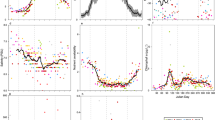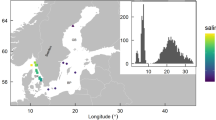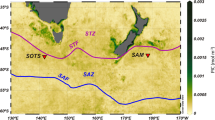Abstract
Marine diatoms and dinoflagellates play a variety of key ecosystem roles as important primary producers (diatoms and some dinoflagellates) and grazers (some dinoflagellates). Additionally some are harmful algal bloom (HAB) species and there is widespread concern that HAB species may be increasing accompanied by major negative socio-economic impacts, including threats to human health and marine harvesting1,2. Using 92,263 samples from the Continuous Plankton Recorder survey, we generated a 50-year (1960–2009) time series of diatom and dinoflagellate occurrence in the northeast Atlantic and North Sea. Dinoflagellates, including both HAB taxa (for example, Prorocentrum spp.) and non-HAB taxa (for example, Ceratium furca), have declined in abundance, particularly since 2006. In contrast, diatom abundance has not shown this decline with some common diatoms, including both HAB (for example, Pseudo-nitzschia spp.) and non-HAB (for example, Thalassiosira spp.) taxa, increasing in abundance. Overall these changes have led to a marked increase in the relative abundance of diatoms versus dinoflagellates. Our analyses, including Granger tests to identify criteria of causality, indicate that this switch is driven by an interaction effect of both increasing sea surface temperatures combined with increasingly windy conditions in summer.
This is a preview of subscription content, access via your institution
Access options
Subscribe to this journal
Receive 12 print issues and online access
$209.00 per year
only $17.42 per issue
Buy this article
- Purchase on Springer Link
- Instant access to full article PDF
Prices may be subject to local taxes which are calculated during checkout



Similar content being viewed by others
References
Anderson, D. M. in Red Tides: Biology, Environmental Science and Toxicology (eds Okaichi, T., Anderson, D. M. & Nemoto, T.) 11–16 (Elsevier, 1989).
Hallegraeff, G. M. A review of harmful algal blooms and their apparent global increase. Phycologia 32, 79–99 (1993).
Reid, P. C., Edwards, M., Hunt, H. G. & Warner, A. J. Phytoplankton change in the North Atlantic. Nature 391, 546–546 (1998).
Moore, S. K., Mantua, N. J., Hickey, B. M. & Trainer, V. L. Recent trends in paralytic shellfish toxins in Puget Sound, relationships to climate, and capacity for prediction of toxic events. Harmful Algae 8, 463–477 (2009).
Hallegraeff, G. M. Ocean climate change, phytoplankton community responses, and harmful algal blooms: A formidable predictive challenge. J. Phycol. 46, 220–235 (2010).
Richardson, A. J. et al. Using Continuous Plankton Recorder data. Prog. Oceanogr. 68, 27–74 (2006).
Escalera, L., Pazos, Y., Morono, A. & Reguera, B. Noctiluca scintillans may act as a vector of toxigenic microalgae. Harmful Algae 6, 317–320 (2007).
Okaichi, T. & Nishio, S. Identification of ammonia as the toxic principle of red tide of Noctiluca miliaris. Bull. Plankton Soc. Jpn 23, 25–30 (1976).
R Development Core Team R: A Language and Environment for Statistical Computing (R Foundation for Statistical Computing Vienna, Austria, 2009) available at http://www.R-project.org.
Pebesma, E. J. & Bivand, R. S. Classes and methods for spatial data in R. R. News 5, 9–13 (2005).
Pebesma, E. J. Multivariable geostatistics in S: The gstat package. Comput. Geosci. 30, 683–691 (2004).
Fraga, S. & Bakun, A. in Toxic Phytoplankton Blooms in the Sea (eds Smayda, T. J. & Shimizu, Y.) 59–65 (Elsevier Science Publisher, 1993).
Fehling, J. et al. Domoic acid production by Pseudo-nitzschia seriata (Bacillariophyceae) in Scottish waters. J. Phycol. 40, 622–630 (2004).
Fehling, J., Davidson, K., Bolch, C. & Tett, P. Seasonality of Pseudo-nitzschia spp. (Bacillariophyceae) in western Scottish waters. Mar. Ecol. Prog. Ser. 323, 91–105 (2006).
Fehling, J., Davidson, K. & Bates, S. S. Growth dynamics of non-toxic Pseudo-nitzschia delicatissima and toxic P. seriata (Bacillariophyceae) under simulated spring and summer photoperiods. Harmful Algae 4, 763–769 (2005).
Beaugrand, G. et al. Reorganization of North Atlantic marine copepod biodiversity and climate. Science 296, 1692–1694 (2002).
Pyper, B. J. & Peterman, R. M. Comparison of methods to account for autocorrelation in correlation analyses of fish data. Can. J. Fish. Aquat. Sci. 55, 2127–2140 (1998).
Thurman, W. N. & Fisher, M. E. Chickens, eggs, and causality, or which came 1st. Am. J. Agr. Econ. 70, 237–238 (1988).
Mann, K. H. & Lazierm, J. R. N. Dynamics of Marine Ecosystems. Biological—Physical Interactions in the Oceans (Blackwell, 1996).
Margalef, R. Life-forms of phytoplankton as survival alternatives in an unstable environment. Oceanol. Acta 1, 493–509 (1978).
Ross, O. N. & Sharples, J. Phytoplankton motility and the competition for nutrients in the thermocline. Mar. Ecol. Prog. Ser. 347, 21–38 (2007).
Berdalet, E. et al. Species-specific physiological response of dinoflagellates to quantified small-scale turbulence. J. Phycol. 43, 965–977 (2007).
Smayda, T. J. Adaptations and selection of harmful and other dinoflagellate species in upwelling systems 1. Morphology and adaptive polymorphism. Prog. Oceanogr. 85, 53–70 (2010).
Tomas, C. R. in Identifying Marine Phytoplankton (ed. Tomas, C. R.) (Academic, 1997).
Acknowledgements
A funding consortium made up of governmental agencies from Canada, France, Iceland, Ireland, the Netherlands, Portugal, the UK and the US financially supports the CPR survey. G.C.H. was supported by the Climate Change Consortium for Wales (C3W). S.L.H. was financially supported by a NERC doctoral training grant (NE/G524344/1) awarded to M.B.G. and G.C.H.
Author information
Authors and Affiliations
Contributions
G.C.H. and M.B.G. conceived the study; S.L.H. and A.W.W. compiled the data; S.L.H., M.B.G. and G.C.H. led the data analyses and interpretation with contributions from all authors. S.L.H. and G.C.H. wrote the paper with contributions from all authors.
Corresponding author
Ethics declarations
Competing interests
The authors declare no competing financial interests.
Supplementary information
Rights and permissions
About this article
Cite this article
Hinder, S., Hays, G., Edwards, M. et al. Changes in marine dinoflagellate and diatom abundance under climate change. Nature Clim Change 2, 271–275 (2012). https://doi.org/10.1038/nclimate1388
Received:
Accepted:
Published:
Issue Date:
DOI: https://doi.org/10.1038/nclimate1388
This article is cited by
-
Plastic responses lead to increased neurotoxin production in the diatom Pseudo-nitzschia under ocean warming and acidification
The ISME Journal (2023)
-
Shifts in periphyton research themes over the past three decades
Environmental Science and Pollution Research (2023)
-
Plankton response to global warming is characterized by non-uniform shifts in assemblage composition since the last ice age
Nature Ecology & Evolution (2022)
-
Improved seasonal prediction of harmful algal blooms in Lake Erie using large-scale climate indices
Communications Earth & Environment (2022)
-
Climate variability and multi-decadal diatom abundance in the Northeast Atlantic
Communications Earth & Environment (2022)



